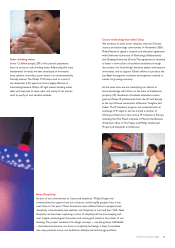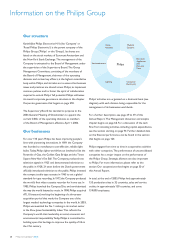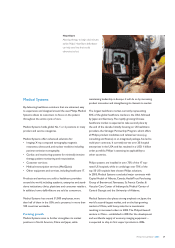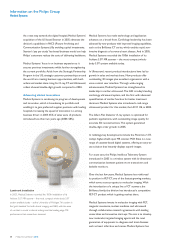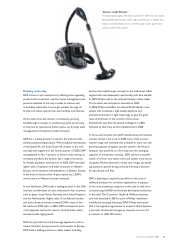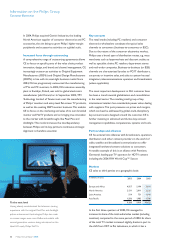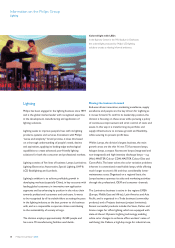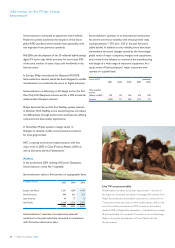Philips 2005 Annual Report Download - page 34
Download and view the complete annual report
Please find page 34 of the 2005 Philips annual report below. You can navigate through the pages in the report by either clicking on the pages listed below, or by using the keyword search tool below to find specific information within the annual report.
Philips Annual Report 200534
Information on the Philips Group
Domestic Appliances and Personal Care
Markets
In the product/market combinations that it is targeting,
DAP has No. 1 or No. 2 market positions in the categories
of male shaving, beauty, oral healthcare, food and beverage,
andgarmentcare,aswellasaNo.3positioninoorcare.
DAP sales to third parties on a geographic basis:
in millions of euros 2003 2004 2005
Europe and Africa 1,201 1,174 1,247
North America 524 456 460
Latin America 87 96 121
AsiaPacic 319 318 366
2,131 2,044 2,194
DAP’s business is seasonal, with very strong sales in the
second (Mother’s and Father’s Day) and fourth quarters
(Christmas and year-end holidays).
In one of its markets, Western Europe, DAP and many
of its A-brand Western competitors have focused on
innovative and somewhat premium-priced appliances. In
defending DAP’s position against the no-frills, unbranded
manufacturers, it remains a continuous challenge to brand
andcommunicatethebenetsoftheseinnovativefeatures
to justify the price premium for its more traditional and
price-conscious consumer segments.
Sourcing
DAP purchases components and materials primarily from
its suppliers in the regions where manufacturing centers
are located. However, some key components (e.g. chargers,
adaptors, DC motors) are sourced globally. DAP buys
the great majority of the components needed for the
manufacture of its products from third parties. In order
to reduce supply risks, DAP’s practice is to have at least
two sources for the majority of components. In addition,
this practice enables the acquisition of components at
competitive market prices. In a limited number of cases
there is a dependence on a single source of components
due to a unique differentiating technology for product
performance and/or cost. In such cases, DAP generally
decides to enter into a partnership agreement in addition
to supply agreements.
Distribution channels
Retail trade and wholesalers form the typical sales channel
to consumer end-users. Due to the nature of its business,
DAP uses a broad span of distribution routes, e.g. mass
merchants such as hypermarkets and discount outlets as
well as specialist chains, department stores and mail-order
companies. It can be expected that the level of competition
in some segments of the small domestic appliances market,
and especially oral healthcare, will intensify. Consolidation
of competitors provides them with better access and
leverage to (FMCG) distribution channels and certain
developing markets. DAP
believes this can best be countered
by global, multidisciplinary
key-account teams designed
around the customer.
Regulatory requirements
By entering the consumer health and wellness domain,
DAP will be confronted with an increasing array of
regulatory requirements for its products. Compliance
with its regulatory environment (which is expected to
be dominated by medical regulations) is key for DAP
and will be pursued vigorously.
DAP’s processes and products need to be consistent with
the relevant regional or national regulatory requirements.
Such legislation includes the EU WEEE (Waste from
Electrical and Electronic Equipment) Directive and the
RoHS (Restriction of Hazardous Substances) Directive.
Strategy and 2006 objectives
DAP has an ambitious annual comparable growth target of
7% while maintaining an EBIT margin of 15%. The division
also sees strong potential to grow through the newly
formed Consumer Health & Wellness business. DAP’s
strategy for 2006 and beyond targets growth through
speed, focus and innovation.
DAPwantstomaximizesustainableprotablegrowthby:
investing in advertising and promotion, R&D and
breakthrough innovation;
focusing on key established and emerging markets;
expanding into adjacent business opportunities;
driving integral customer management with leading
customers via One Philips key-account management.
•
•
•
•





